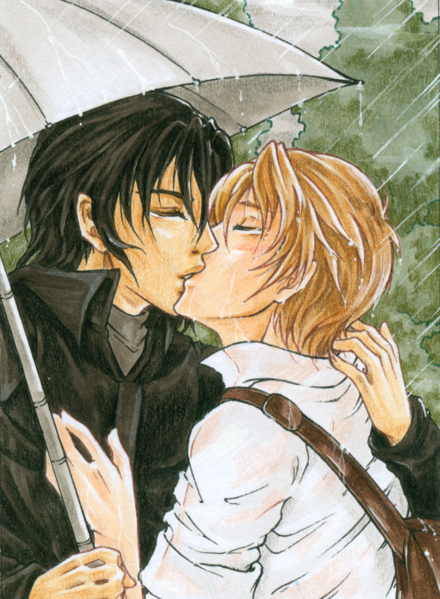ShÅnen, shonen, or shounen manga (å°'年漫ç"», shÅnen manga) is manga aimed at a male audience. It appeals to a large age group, though its primary audience stays roughly between the ages of 10 and 18. The Kanji characters (å°'å¹´) mean "boy" or "youth"; the characters (漫ç"») mean "cartoon" or "comic". The complete phrase literally means "young person's comic" or simply "boys' comic". ShÅnen manga has been said to be the most popular form of manga. The female equivalent to shÅnen manga is shÅjo manga.
Summary

ShÅnen (å°'å¹´) manga (漫ç"») is typically characterized by high-action, often humorous plots featuring male protagonists. The camaraderie between boys or men on sports teams, fighting squads and the like is often emphasized. Attractive female characters with exaggerated features are also common, such as Bulma from Dragon Ball or Nami from One Piece (see fan service). Main characters may also feature an ongoing desire to better themselves.
Such manga often portray challenges to the protagonist's abilities, skills, and maturity, stressing self-perfection, austere self-discipline, sacrifice in the cause of duty, and honorable service to society, community, family, and friends.
None of these listed characteristics are a requirement, as seen in shÅnen manga like Yotsuba&!, which features a female lead and almost no fan service or action; what most defines whether or not a series is shÅnen are things like the magazine (see Weekly ShÅnen Jump) it is serialized in or the time slot it airs on T.V. After the case of Tsutomu Miyazaki, depictions of violence and sexual matters became more highly regulated in manga in general, but especially in shÅnen manga. The art style of shÅnen is generally less "flowery" than that of shÅjo manga, although this varies greatly from artist to artist, and some artists draw both shÅnen and shÅjo manga.
Different shÅnen manga stories may feature different themes, such as martial arts, robots, science fiction, sports, terror, and mythological creatures.
ShÅnen manga today
Akira Toriyama's Dragon Ball (1984â€"1995) is credited with setting the trend of popular shÅnen manga from the 1980s onward, with manga critic Jason Thompson in 2011 calling it "by far the most influential shÅnen manga of the last 30 years." The influence and popularity of the series had reached many currently successful shÅnen authors such as Eiichiro Oda, Masashi Kishimoto, Tite Kubo, Togashi Yoshihiro, Akira Amano, Mitsutoshi Shimabukuro and Hiro Mashima, who continue to pay homage to his impact and influence in their own works.
History

Before World War II
Manga has said to exist since the eighteenth century, but originally did not target a specific gender or age group. By 1905, however, a boom in publishing manga magazines occurred, and began targeting genders as evidenced by their names, such as ShÅnen Sekai, ShÅjo Sekai, and ShÅnen Pakku (a kodomo manga magazine). ShÅnen Sekai was one of the first shÅnen manga magazines, and was published from 1895 to 1914.
Post-Occupation
The post-World War II occupation of Japan had a profound impact on its culture during the 1950s and beyond (see culture of Post-occupation Japan), including on manga. Modern manga developed during this period, including the modern format of shÅnen manga we experience today, of which boys and young men were among the earliest readers. During this time, ShÅnen manga focused on topics thought to interest the archetypical boy: sci-tech subjects like robots and space travel, and heroic action-adventure. Osamu Tezuka, creator of Astro Boy (鉄腕アトム, Tetsuwan Atomu, "Mighty Atom," lit. "Iron Arm Atom") is said to have played an influential role in manga during this period. Between 1950 and 1969, an increasingly large readership for manga emerged in Japan with the solidification of its two main marketing genres, shÅnen manga aimed at boys and shÅjo manga aimed at girls.
The magazine Weekly ShÅnen Jump began production in 1968, and continues to be produced today as the best-selling manga magazine in Japan. Many of the most popular shÅnen manga titles have been serialized in Jump, including Dragon Ball, Naruto, Bleach, One Piece, Slam Dunk, Captain Tsubasa, and others (see List of series run in Weekly ShÅnen Jump).
With the relaxation of censorship in Japan in the 1990s, a wide variety of explicit sexual themes appeared in manga intended for male readers, and correspondingly occur in English translations; however, in 2010 the Tokyo Metropolitan Government passed a bill to restrict harmful content.
Women's roles in shÅnen manga

In early shÅnen manga, men and boys played all the major roles, with women and girls having only auxiliary places as sisters, mothers, and occasionally girlfriends. Of the nine cyborgs in Shotaro Ishinomori's 1964 Cyborg 009, only one is female, and she soon vanishes from the action. Some recent shÅnen manga virtually omit women, e.g. the martial arts story Baki the Grappler by Itagaki Keisuke, and the supernatural fantasy Sand Land by Akira Toriyama. By the 1980s, however, girls and women began to play increasingly important roles in shÅnen manga. For example, in Toriyama's 1980 Dr. Slump, the main character is the mischievous and powerful girl robot Arale Norimaki.
The role of girls and women in manga for male readers has evolved considerably since Arale. One class is the pretty girl (bishÅjo). Sometimes the woman is unattainable, and she is always an object of the hero's emotional and/or sexual interest, like Belldandy from Oh My Goddess! by KÅsuke Fujishima and Shao-lin from Guardian Angel Getten by Minene Sakurano. In other stories, the hero is surrounded by such girls and women, as in Negima by Ken Akamatsu and Hanaukyo Maid Team by Morishige. The male protagonist does not always succeed in forming a relationship with the woman, for example when Bright Honda and Aimi Komori fail to bond in Shadow Lady by Masakazu Katsura. In other cases, a successful couple's sexual activities are depicted or implied, like in Outlanders by Johji Manabe. In still other cases, the initially naive and immature hero grows up to become a man by learning how to deal and live with women emotionally and sexually; examples of heroes who follow this path include Yota in Video Girl Ai by Masakazu Katsura and Train Man in Train Man: Densha Otoko by Hidenori Hara. However, since the 90s, women have acquired a heightened role in various manga, albeit lesser in number. They are often portrayed as central characters or characters with important roles in manga. Some examples include InuYasha, Ranma ½, and Fairy Tail.
Examples of shÅnen manga that feature female protagonists include Fairy Tail, Soul Eater and It's Not My Fault That I'm Not Popular!
List of shÅnen manga

Examples of shÅnen manga include Shaman King, Baka and Test, Fist of the North Star, Death Note, Dragon Ball, JoJo's Bizarre Adventure, Beyblade, One Piece, Naruto, Astro Boy, Pandora Hearts, Rurouni Kenshin, Kinnikuman, Saint Seiya, Dr. Slump, Gin Tama, Fighting Spirit, Detective Conan, YuYu Hakusho, Code Geass, Hunter × Hunter, Reborn!, Bleach, Soul Eater, Air Gear, Slam Dunk, Zatch Bell!, Fairy Tail, Tsubasa: Reservoir Chronicle, Yu-Gi-Oh!, Fullmetal Alchemist, Ranma ½, Attack on Titan, Blue Exorcist, Magi: The Labyrinth of Magic, Sket Dance, Kuroko's Basketball, Deadman Wonderland, Toriko,D.Gray-man, Pokemon Adventures, and InuYasha.


Posting Komentar